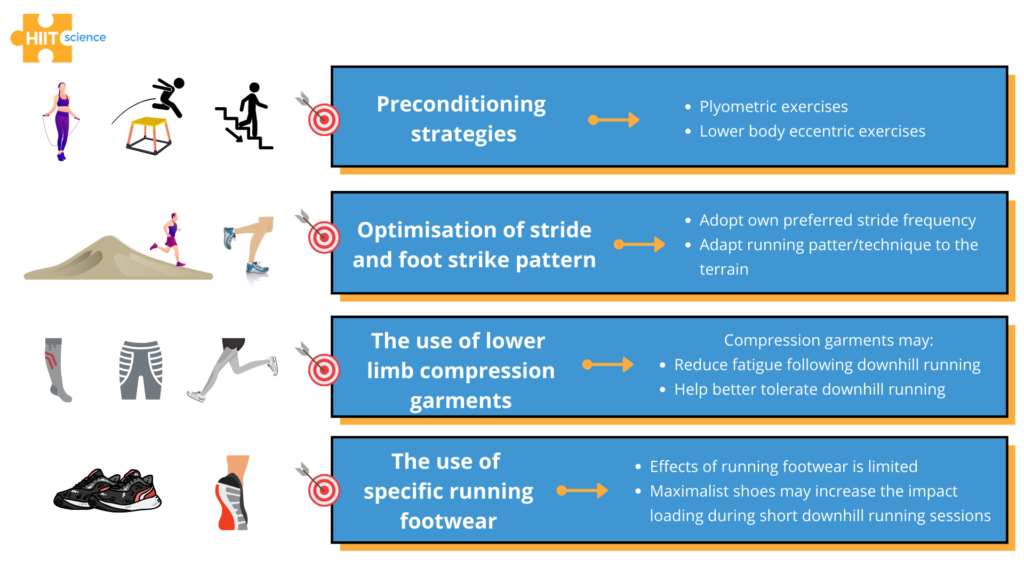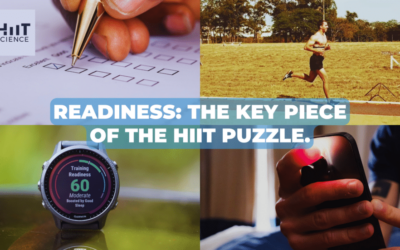Introduction
Downhill running sections are a natural part of off-road (e.g. cross-country, trail or ultramarathon running) and road running races (e.g. the St. George marathon, the Holualoa Tuscon marathon, the Big Sur International marathon). However, downhill running is often a missed component in an athletes’ training routine.Due to its strenuous and eccentric-based nature, downhill running may play a major role in the occurrence of muscle damage and fatigue in races, and thus represents a challenge for runners.From a training standpoint, inclusion of periods of downhill running naturally elicits a neuromuscular loading response. In our recent review published in Sports Medicine, titled ‘Downhill Running: What Are The Effects and How Can We Adapt? A Narrative Review’ (Bontemps et al. 2020), we discussed the impact of negative slopes on the physiological parameters related to performance and recovery, as well as the current state of knowledge on the strategies to better tolerate downhill running. We believe that considering the impact of downhill sections in running is crucial for the preparation of athletes, and that downhill running may also be used as a training tool by athletes and practitioners. Herein we explain what downhill running is and propose a rationale for its implementation in the athlete’s training programme.
Downhill running: what is it?
Running downhill differs from running on the flat. When compared to level running, downhill running is characterised by eccentric muscle actions (i.e. contracting while the muscle is lengthening) accompanied with greater mechanical strain applied to lower-limb muscles during the foot-ground contact time. These grade-specific changes accentuate muscle damage and neuromuscular fatigue and may dramatically affect running performance and the post-exercise recovery process. Muscle damage and neuromuscular fatigue following downhill running have been extensively studied in the laboratory. Using a microscope, classical signs of muscle damage are ultrastructural damaged fibres, inflammatory oedema, and an important leakage of muscle-specific proteins into the blood.These structural alterations are typically accompanied with muscle soreness and functional alterations, including loss of maximal strength production of lower limbs (i.e., neuromuscular fatigue, originating at muscle and neural levels) and reduced range of motion.In addition, a reduction of running economy (i.e. characterized by a greater oxygen demand for a given speed), which is a major determinant of running performance and success in competitive distance running, is typically reported following downhill running (figure 1). It is important to note that all these alterations may persist for 1 to 7 days after a downhill run.

Figure 1. Immediate and prolonged physiological and perceptual alterations following downhill running; DR: downhill running. The illustration of the running man is adapted from ©maximmmmum/Adobe Stock. The graphical panels are adapted from (Bontemps et al. 2020).
Factors influencing the extent of muscle damage in downhill running
In general, the more trained in endurance running an athlete is, the lower the extent of muscle damage and neuromuscular fatigue induced by downhill running.For example, we found that maximal strength production capacity is reduced by 23.5% and 16.4% on average in untrained and trained runners, respectively.Because the maximal strength production capacity is one of the most important predictors of performance in downhill running (Lemire et al. 2020), limiting its loss during downhill running sections might enhance tolerance to exercise, mitigate alterations in running economy, thus improving performance and recovery time. We believe that endurance-trained runners accustomed to resistance training and/or downhill running might benefit from greater protective effects of previous downhill runs. Based on these observations, it is recommended that runners who aim to perform in races including notable negative slopes implement resistance training and/or specific downhill running sessions in their training routine weeks to months prior to the race.
Downhill running: a unique training strategy
Repeating two bouts of strenuous exercise (that induce muscle damage) such as downhill running, separated by several days is well known to attenuate markers of muscle damage (such as muscle soreness) after the second bout.This protective mechanism is termed the ‘repeated bout effect’ (McHugh et al. 1999) and could be interpreted as a ‘muscle memory’.In a nutshell, the repeated bout effect following downhill running sessions attenuates alterations in maximal strength production capacity, muscle structure and running economy. This muscle memory may last up to 6 weeks, although benefits decrease with time. As such, we recommend athletes maximise this protective effect in training by incorporating at least one downhill running session within the weeks prior to off-road and/or road races, and especially in beginners and/or runners not accustomed to negative slopes. If only one downhill running session can confer a protective mechanism against muscle damage and fatigue, we may wonder what the effects of chronic downhill run training could be. Although the dose-response effect of downhill running training on the repeated bout effect has been scarcely investigated thus far, researchers suggest that the longer the training period (10 sessions versus 5 sessions) the greater the benefits (Schwane et al. 1987).
Thus, implementing downhill running sessions into the training routine may confer a greater and longer protective mechanism against muscle damage and neuromuscular fatigue occurring when running on negative slopes.Resistance training (composed of plyometric and/or eccentric-based exercises) is usually proposed as a strategy to improve maximal strength of lower limbs and running economy in endurance runners. Because downhill running is an eccentric-based exercise, repeated downhill running sessions may also stimulate adaptations to the musculotendinous and neural system, improve maximal strength production (Toyomura et al. 2018), and may enhance running economy on flat and/or negative slopes. Accordingly, downhill run training may be incorporated in the training of off-road and road runners in order to improve the tolerance to negative slopes, and possibly enhance performance in races.
More specifically, we recommend runners leave their flat training runs at least once a week and head for the slopes.The implementation of run speed fluctuations in the form of intervals run at high speed on downhill slopes need to be approached with caution however, as this requires a certain degree of familiarisation. For beginners, we suggest finding a hill and training multiple times on it in order to gain confidence, technique and increase one’s tolerance to the demanding nature of downhill running. In downhill sections, a greater mechanical stress and power are applied to the knee and ankle compared to level grade, which may require longer recovery times post-training sessions, especially at the beginning of implementation.
Additional strategies to better tolerate downhill running in training and racing
Preconditioning strategies
Classical resistance exercises with a plyometric or eccentric component that are performed within days prior to a downhill running session may also confer a repeated bout effect (Eston et al. 1996).Although downhill run training is probably the most effective strategy, preconditioning exercises present as a good alternative for athletes who live in flat regions and/or in northern countries where the winter weather may not permit outdoor training.For runners who do not have access to a gym, there is still a variety of exercises that can be done with minimal equipment (resistance bands, bench, chair, stairs) to replicate the eccentric contractions occurring in downhill running. Interestingly, implementing preconditioning exercises that do not induce significant muscle damage (such as isometric or concentric-based contractions) may also confer, albeit smaller, a repeated bout effect (Lima et al. 2018). This latter strategy may be particularly recommended to runners aiming to benefit from the protective mechanisms against muscle damage in short proximity to competitions and/or during intense endurance training periods.
Optimisation of stride and foot strike pattern
The manipulation of foot stride (i.e. length and frequency) and/or foot strike pattern (i.e. rear-, mid- and fore-foot) can influence the mechanical strain applied to lower-limb muscles during downhill running. The effects of manipulating foot stride during downhill running on muscle damage and neuromuscular fatigue is still unclear.However, it seems that adopting a stride pattern close to the runner’s preferred stride frequency may be the best strategy to optimise running economy in race (Vincent et al. 2019).Optimal foot strike pattern in downhill sections is still to be determined, however it has been observed that the best runners spontaneously adapt their running pattern, technique, and propulsive function to the varied characteristics of the terrain (Vernillo et al. 2019; Giandolini et al. 2017).
The use of lower limb compression garments
Although wearing lower-limb compression garments after exercise has been shown to facilitate the recovery process, researchers are still debating their effects when worn during exercise. Only few studies have investigated the effects of compression garments (covering the quadriceps or calves) on muscle damage and/or fatigue following downhill running and/or races involving negative slopes. Overall, results report beneficial effects of compression garments in reducing fatigue of quadriceps muscles following downhill running (Ehrstrom et al. 2018).The main hypothesis is that compression garments may exert a ‘dynamic immobilization’, thus reducing muscle vibrations, which would limit the occurrence of neuromuscular fatigue as well as reduce muscle activity during the run.In parallel, a lower proportion of injured muscle fibres (-26.7% on average) was reported in runners wearing compression garments covering the quadriceps (Valle et al. 2013). Compression garments may, therefore, help better tolerate downhill running in races and/or intense downhill run training sessions. Recreational runners and masters athletes (> 40 years) more prone to muscle damage may benefit the most from compression garments. Wearing compression garments could also increase the adherence to training by limiting muscle soreness as well as the risk of muscle–tendon injuries thanks to a reduction in impact shock accelerations during long duration and/or downhill running sessions. We suggest using compression garments covering the quadriceps, which are particularly recruited during downhill running.
The use of specific running footwear
Despite a growing interest in the development of innovative running shoes (i.e. minimalist vs. maximalist shoes), their effects seem to be limited during downhill running regardless of the footwear characteristics (e.g. shoe mass, drop height, suctioning) (Hardin and Hamill, 2020). In addition, it has been suggested that maximalist shoes might not be capable of reducing the impact loading on level grade and might even increase the external impact loading during short downhill running sessions (Chan et al. 2018). Table 1. Current level of scientific evidence supporting the benefits of different strategies to better tolerate downhill running. The level of evidence (with more stars denoting a higher scientific evidence) was determined according to the abundance of data available and the number of studies reporting the same outcomes Adapted from Bontemps et al. (2020).
Table 1. Current level of scientific evidence supporting the benefits of different strategies to better tolerate downhill running. The level of evidence (with more stars denoting a higher scientific evidence) was determined according to the abundance of data available and the number of studies reporting the same outcomes Adapted from Bontemps et al. (2020).
Summary and practical recommendations
In summary, downhill running appears as a potent stimulator of training adaptation in disciplines involving running activities and for runners in particular.Although the physiological effects of downhill running are well known, the concept of downhill run training is novel and may represent another tool in the coaches’ toolbox to manipulate the neuromuscular variable and enhance training adaptation.Incorporating downhill running sessions on a regular basis (e.g. once a week) or training on an irregular terrain, seems to be the best strategy to reduce the extent of muscle damage and neuromuscular fatigue induced by downhill sections. Such a strategy could also improve performances on level grade. For people who are not accustomed to downhill running, we recommend repeating the same downhill sections at low intensity during multiple sessions as part of their training routine in the aim of gaining confidence whilst improving their technique. Coaches need to be aware that muscle soreness may persist for several days following the first session. The training programme (volume and intensity of the neuromuscular stimulus) should be adapted accordingly to allow for adaptation and recovery. In the early stages of downhill run training, some running sessions could thus be replaced by non-bearing activities such as cycling or swimming, to lower the neuromuscular impact whilst maintaining load on the aerobic oxidative and/or anaerobic glycolytic responses (see HIIT Science for more details). In addition, use of lower limb compression garments may be considered to facilitate the downhill running performance, in particular for people more prone to muscle damage (masters and recreational athletes) and/or for racing. However, no specific foot stride or strike pattern, nor running shoe. has ever proven beneficial for better tolerance to downhill running.

Figure 2. Practical applications when applying downhill running into your training programme.
About the authors
 Bastien Bontemps is a Ph.D. student in Sport and Exercise Sciences who is interested in running performance and recovery optimisation of road and off-road runners. His PhD work aims to investigate the effects of preventive (i.e. pre-exercise and in-situ) strategies to better tolerate exercise-induced muscle damage and fatigue following strenuous running exercise, and in particular following downhill running bouts. Twitter: @BontempsBastien; Email: bastien-bontemps@etud.univ-tln.fr
Bastien Bontemps is a Ph.D. student in Sport and Exercise Sciences who is interested in running performance and recovery optimisation of road and off-road runners. His PhD work aims to investigate the effects of preventive (i.e. pre-exercise and in-situ) strategies to better tolerate exercise-induced muscle damage and fatigue following strenuous running exercise, and in particular following downhill running bouts. Twitter: @BontempsBastien; Email: bastien-bontemps@etud.univ-tln.fr
 Julien Louis is Reader in Nutrition and Exercise Physiology at Liverpool John Moores University, in Liverpool (UK). His research aims to identify the best training, nutritional and recovery strategies for optimising sports performance in elite athletes. Twitter: @Jlnlouis; Email: J.B.Louis@ljmu.ac.uk
Julien Louis is Reader in Nutrition and Exercise Physiology at Liverpool John Moores University, in Liverpool (UK). His research aims to identify the best training, nutritional and recovery strategies for optimising sports performance in elite athletes. Twitter: @Jlnlouis; Email: J.B.Louis@ljmu.ac.uk
 Mathieu Gruet is an Associate Professor in exercise physiology at the Faculty of Sport Sciences, University of Toulon, France. His research interests and expertise focus on the neurophysiological and psychophysiological factors underlying exercise performance and fatigability in various contexts and populations. Twitter: @GruetMathieu; Email: gruet@univ-tln.fr
Mathieu Gruet is an Associate Professor in exercise physiology at the Faculty of Sport Sciences, University of Toulon, France. His research interests and expertise focus on the neurophysiological and psychophysiological factors underlying exercise performance and fatigability in various contexts and populations. Twitter: @GruetMathieu; Email: gruet@univ-tln.fr
 Fabrice Vercruyssen is Senior lecturer in sport and exercise sciences at the “Impact of Physical Activity on Health” laboratory at the University of Toulon (France). His research focuses on the identification of internal and external factors affecting metabolic efficiency, fatigue and performance in adults and children. Twitter: @f_vercruyssen; Email: vercruyssen@univ-tln.fr
Fabrice Vercruyssen is Senior lecturer in sport and exercise sciences at the “Impact of Physical Activity on Health” laboratory at the University of Toulon (France). His research focuses on the identification of internal and external factors affecting metabolic efficiency, fatigue and performance in adults and children. Twitter: @f_vercruyssen; Email: vercruyssen@univ-tln.fr







